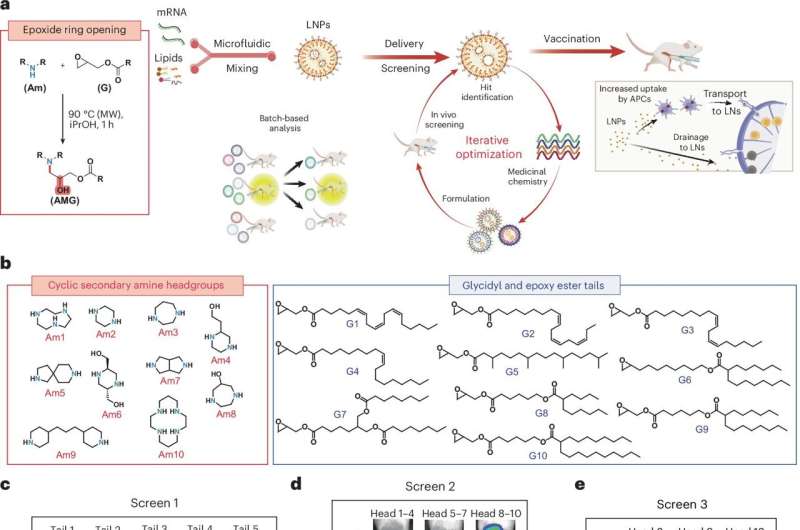Researchers at the Massachusetts Institute of Technology (MIT) have developed a new type of nanoparticle that significantly improves the delivery of mRNA vaccines. This advancement could not only enhance vaccine effectiveness but also reduce costs associated with vaccine production. In experiments conducted on mice, the new lipid nanoparticle (LNP) formulation demonstrated the ability to elicit strong immune responses using only 1/100 of the dose required by traditional delivery methods.
Daniel Anderson, a professor in MIT’s Department of Chemical Engineering and a prominent member of the Koch Institute for Integrative Cancer Research, emphasized the financial implications of this breakthrough. “One of the challenges with mRNA vaccines is the cost,” he noted. “When you think about the cost of making a vaccine that could be distributed widely, it can really add up.” The goal of this research is to create nanoparticles that can provide a safe and effective vaccine response while using significantly lower dosages.
The study, published in Nature Nanotechnology, highlights how the new LNPs could be utilized not only for influenza vaccines but also for other diseases, including COVID-19. The lead authors, Arnab Rudra, Akash Gupta, and Kaelan Reed, played crucial roles in the research and development of these innovative particles.
Enhancing Vaccine Delivery
To protect mRNA from degradation in the body, it is typically encapsulated within lipid nanoparticles. These particles facilitate the entry of mRNA into cells, where it can subsequently instruct the cells to produce proteins that trigger an immune response. The challenge has been to enhance the efficiency of these particles while minimizing the required dosage.
The MIT team focused on improving the ionizable lipid component of the LNPs, which is essential for their effectiveness. They designed a library of new lipids featuring cyclic structures and ester chemical groups, which are expected to improve both delivery efficacy and biodegradability. Through a series of tests in mice, the researchers identified their top-performing particle, which they named AMG1541.
This novel LNP formulation excels in a critical aspect of vaccine delivery known as endosomal escape. Once inside cells, LNPs are often trapped in endosomes, cellular compartments from which they must escape to deliver their mRNA payload. The AMG1541 nanoparticles exhibited a remarkable ability to break free from these compartments, enhancing the delivery of mRNA compared to existing formulations.
Additionally, the ester groups incorporated into these new particles enable them to degrade post-delivery. This characteristic allows for quicker clearance from the body, potentially reducing side effects associated with the vaccine.
Potential Applications and Future Impacts
To demonstrate the effectiveness of AMG1541, the team tested its ability to deliver an mRNA influenza vaccine in mice. They compared its performance to a flu vaccine formulated with SM-102, a lipid used in Moderna’s COVID-19 vaccine and approved by the FDA. The results showed that mice receiving the new LNP generated the same level of antibody response with only 1/100 of the dose required by the SM-102 formulation.
Rudra expressed optimism about the implications of their findings, stating, “It’s almost a hundredfold lower dose, but you generate the same amount of antibodies, so that can significantly lower the dose. If it translates to humans, it should significantly lower the cost as well.”
Further investigations revealed that the new LNPs are more effective at delivering mRNA to antigen-presenting cells, which play a vital role in initiating immune responses. These cells display foreign antigens on their surfaces, prompting activation of other immune cells, such as B and T cells. The AMG1541 particles also showed enhanced accumulation in lymph nodes, which are critical sites for immune activation.
The researchers believe that the adaptability of these LNPs could extend to vaccines for a range of infectious diseases, including COVID-19 and HIV. Gupta remarked on the potential applications, stating, “We have found that they work much better than anything that has been reported so far. That’s why, for any intramuscular vaccines, we think that our LNP platforms could be used to develop vaccines for a number of diseases.”
With the ability to produce mRNA vaccines more rapidly and accurately match circulating strains, particularly for influenza, this research could revolutionize vaccine development and distribution in the coming years.
The full study can be accessed in the journal Nature Nanotechnology, providing comprehensive insights into this significant advancement in mRNA vaccine technology.



































































